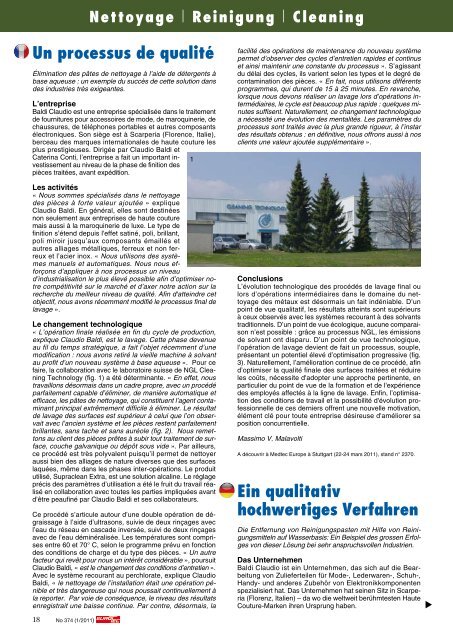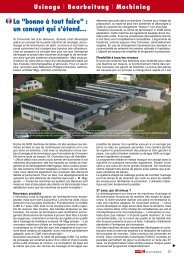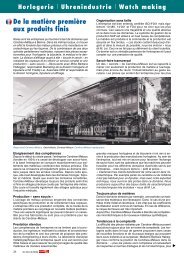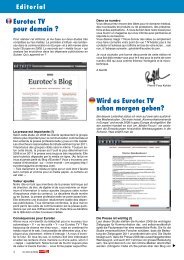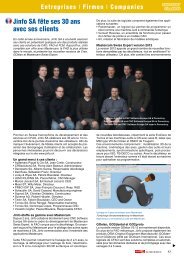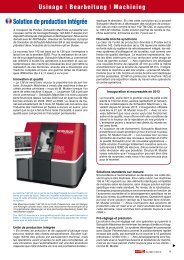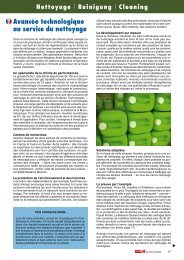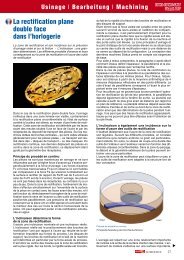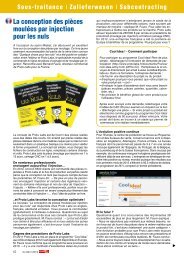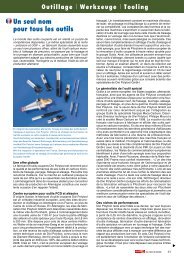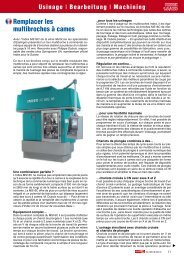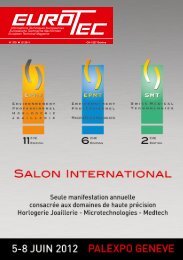Ein qualitativ hochwertiges Verfahren Un processus de qualité
Ein qualitativ hochwertiges Verfahren Un processus de qualité
Ein qualitativ hochwertiges Verfahren Un processus de qualité
Create successful ePaper yourself
Turn your PDF publications into a flip-book with our unique Google optimized e-Paper software.
18 No 374 (1/2011)<br />
Nettoyage l Reinigung l Cleaning<br />
<strong>Un</strong> <strong>processus</strong> <strong>de</strong> <strong>qualité</strong><br />
Élimination <strong>de</strong>s pâtes <strong>de</strong> nettoyage à l’ai<strong>de</strong> <strong>de</strong> détergents à<br />
base aqueuse : un exemple du succès <strong>de</strong> cette solution dans<br />
<strong>de</strong>s industries très exigeantes.<br />
L’entreprise<br />
Baldi claudio est une entreprise spécialisée dans le traitement<br />
<strong>de</strong> fournitures pour accessoires <strong>de</strong> mo<strong>de</strong>, <strong>de</strong> maroquinerie, <strong>de</strong><br />
chaussures, <strong>de</strong> téléphones portables et autres composants<br />
électroniques. son siège est à scarperia (florence, italie),<br />
berceau <strong>de</strong>s marques internationales <strong>de</strong> haute couture les<br />
plus prestigieuses. dirigée par claudio Baldi et<br />
caterina conti, l’entreprise a fait un important in- 1<br />
vestissement au niveau <strong>de</strong> la phase <strong>de</strong> finition <strong>de</strong>s<br />
pièces traitées, avant expédition.<br />
Les activités<br />
« Nous sommes spécialisés dans le nettoyage<br />
<strong>de</strong>s pièces à forte valeur ajoutée » explique<br />
claudio Baldi. en général, elles sont <strong>de</strong>stinées<br />
non seulement aux entreprises <strong>de</strong> haute couture<br />
mais aussi à la maroquinerie <strong>de</strong> luxe. le type <strong>de</strong><br />
finition s’étend <strong>de</strong>puis l'effet satiné, poli, brillant,<br />
poli miroir jusqu’aux composants émaillés et<br />
autres alliages métalliques, ferreux et non ferreux<br />
et l’acier inox. « Nous utilisons <strong>de</strong>s systèmes<br />
manuels et automatiques. Nous nous efforçons<br />
d’appliquer à nos <strong>processus</strong> un niveau<br />
d’industrialisation le plus élevé possible afin d’optimiser notre<br />
compétitivité sur le marché et d’axer notre action sur la<br />
recherche du meilleur niveau <strong>de</strong> <strong>qualité</strong>. Afin d'atteindre cet<br />
objectif, nous avons récemment modifié le <strong>processus</strong> final <strong>de</strong><br />
lavage ».<br />
Le changement technologique<br />
« L’opération finale réalisée en fin du cycle <strong>de</strong> production,<br />
explique Claudio Baldi, est le lavage. Cette phase <strong>de</strong>venue<br />
au fil du temps stratégique, a fait l’objet récemment d’une<br />
modification : nous avons retiré la vieille machine à solvant<br />
au profit d’un nouveau système à base aqueuse ». Pour ce<br />
faire, la collaboration avec le laboratoire suisse <strong>de</strong> ngl cleaning<br />
technology (fig. 1) a été déterminante. « En effet, nous<br />
travaillons désormais dans un cadre propre, avec un procédé<br />
parfaitement capable d’éliminer, <strong>de</strong> manière automatique et<br />
efficace, les pâtes <strong>de</strong> nettoyage, qui constituent l’agent contaminant<br />
principal extrêmement difficile à éliminer. Le résultat<br />
<strong>de</strong> lavage <strong>de</strong>s surfaces est supérieur à celui que l’on observait<br />
avec l’ancien système et les pièces restent parfaitement<br />
brillantes, sans tache et sans auréole (fig. 2). Nous remettons<br />
au client <strong>de</strong>s pièces prêtes à subir tout traitement <strong>de</strong> surface,<br />
couche galvanique ou dépôt sous vi<strong>de</strong> ». Par ailleurs,<br />
ce procédé est très polyvalent puisqu’il permet <strong>de</strong> nettoyer<br />
aussi bien <strong>de</strong>s alliages <strong>de</strong> nature diverses que <strong>de</strong>s surfaces<br />
laquées, même dans les phases inter-opérations. le produit<br />
utilisé, supraclean extra, est une solution alcaline. le réglage<br />
précis <strong>de</strong>s paramètres d’utilisation a été le fruit du travail réalisé<br />
en collaboration avec toutes les parties impliquées avant<br />
d’être peaufiné par claudio Baldi et ses collaborateurs.<br />
ce procédé s’articule autour d’une double opération <strong>de</strong> dégraissage<br />
à l’ai<strong>de</strong> d’ultrasons, suivie <strong>de</strong> <strong>de</strong>ux rinçages avec<br />
l’eau du réseau en casca<strong>de</strong> inversée, suivi <strong>de</strong> <strong>de</strong>ux rinçages<br />
avec <strong>de</strong> l’eau déminéralisée. les températures sont comprises<br />
entre 60 et 70° c, selon le programme prévu en fonction<br />
<strong>de</strong>s conditions <strong>de</strong> charge et du type <strong>de</strong>s pièces. « <strong>Un</strong> autre<br />
facteur qui revêt pour nous un intérêt considérable », poursuit<br />
claudio Baldi, « est le changement <strong>de</strong>s conditions d’entretien ».<br />
avec le système recourant au perchlorate, explique claudio<br />
Baldi, « le nettoyage <strong>de</strong> l’installation était une opération pénible<br />
et très dangereuse qui nous poussait continuellement à<br />
la reporter. Par voie <strong>de</strong> conséquence, le niveau <strong>de</strong>s résultats<br />
enregistrait une baisse continue. Par contre, désormais, la<br />
facilité <strong>de</strong>s opérations <strong>de</strong> maintenance du nouveau système<br />
permet d’observer <strong>de</strong>s cycles d’entretien rapi<strong>de</strong>s et continus<br />
et ainsi maintenir une constante du <strong>processus</strong> ». s’agissant<br />
du délai <strong>de</strong>s cycles, ils varient selon les types et le <strong>de</strong>gré <strong>de</strong><br />
contamination <strong>de</strong>s pièces. « En fait, nous utilisons différents<br />
programmes, qui durent <strong>de</strong> 15 à 25 minutes. En revanche,<br />
lorsque nous <strong>de</strong>vons réaliser un lavage lors d’opérations intermédiaires,<br />
le cycle est beaucoup plus rapi<strong>de</strong> : quelques minutes<br />
suffisent. Naturellement, ce changement technologique<br />
a nécessité une évolution <strong>de</strong>s mentalités. Les paramètres du<br />
<strong>processus</strong> sont traités avec la plus gran<strong>de</strong> rigueur, à l’instar<br />
<strong>de</strong>s résultats obtenus : en définitive, nous offrons aussi à nos<br />
clients une valeur ajoutée supplémentaire ».<br />
Conclusions<br />
l’évolution technologique <strong>de</strong>s procédés <strong>de</strong> lavage final ou<br />
lors d’opérations intermédiaires dans le domaine du nettoyage<br />
<strong>de</strong>s métaux est désormais un fait indéniable. d’un<br />
point <strong>de</strong> vue qualitatif, les résultats atteints sont supérieurs<br />
à ceux observés avec les systèmes recourant à <strong>de</strong>s solvants<br />
traditionnels. d’un point <strong>de</strong> vue écologique, aucune comparaison<br />
n’est possible : grâce au <strong>processus</strong> ngl, les émissions<br />
<strong>de</strong> solvant ont disparu. d’un point <strong>de</strong> vue technologique,<br />
l’opération <strong>de</strong> lavage <strong>de</strong>vient <strong>de</strong> fait un <strong>processus</strong>, souple,<br />
présentant un potentiel élevé d’optimisation progressive (fig.<br />
3). naturellement, l’amélioration continue <strong>de</strong> ce procédé, afin<br />
d’optimiser la <strong>qualité</strong> finale <strong>de</strong>s surfaces traitées et réduire<br />
les coûts, nécessite d'adopter une approche pertinente, en<br />
particulier du point <strong>de</strong> vue <strong>de</strong> la formation et <strong>de</strong> l'expérience<br />
<strong>de</strong>s employés affectés à la ligne <strong>de</strong> lavage. enfin, l’optimisation<br />
<strong>de</strong>s conditions <strong>de</strong> travail et la possibilité d'évolution professionnelle<br />
<strong>de</strong> ces <strong>de</strong>rniers offrent une nouvelle motivation,<br />
élément clé pour toute entreprise désireuse d'améliorer sa<br />
position concurrentielle.<br />
Massimo V. Malavolti<br />
a découvrir à Medtec europe à stuttgart (22-24 mars 2011), stand n° 2370.<br />
<strong>Ein</strong> <strong>qualitativ</strong><br />
<strong>hochwertiges</strong> <strong>Verfahren</strong><br />
Die Entfernung von Reinigungspasten mit Hilfe von Reinigungsmitteln<br />
auf Wasserbasis: <strong>Ein</strong> Beispiel <strong>de</strong>s grossen Erfolges<br />
von dieser Lösung bei sehr anspruchsvollen Industrien.<br />
Das <strong>Un</strong>ternehmen<br />
Baldi claudio ist ein unternehmen, das sich auf die Bearbeitung<br />
von Zulieferteilen für Mo<strong>de</strong>-, le<strong>de</strong>rwaren-, schuh-,<br />
handy- und an<strong>de</strong>res Zubehör von elektronikkomponenten<br />
spezialisiert hat. das unternehmen hat seinen sitz in scarperia<br />
(florenz, italien) – da wo die weltweit berühmtesten haute<br />
couture-Marken ihren ursprung haben.<br />
s
das von claudio Baldi und caterina conti geleitete unternehmen<br />
hat viel in die endbearbeitungsphase <strong>de</strong>r bearbeiteten<br />
teile (vor <strong>de</strong>m Versand) investiert.<br />
Die Tätigkeiten<br />
„Wir haben uns auf die Reinigung von Teilen mit hoher<br />
Wertschöpfung spezialisiert", erklärte uns claudio Baldi. im<br />
allgemeinen sind solche teile nicht nur für haute coutureunternehmen,<br />
aber auch für luxusle<strong>de</strong>rwaren bestimmt. die<br />
endbearbeitungen können sehr unterschiedlich ausgestaltet<br />
sein: sei<strong>de</strong>nglanz, poliert, hochglanz, emaillierte Komponenten<br />
und an<strong>de</strong>re eisenhaltige und nichteisenhaltige Metalllegierungen<br />
sowie e<strong>de</strong>lstahl. „Wir setzen manuelle und automatische<br />
Systeme ein. Wir setzen alles daran, bei unseren<br />
<strong>Verfahren</strong> ein möglichst hohes Industrialisierungsniveau zu<br />
erreichen, um unsere Wettbewerbsfähigkeit auf <strong>de</strong>m Markt zu<br />
optimieren und unsere Tätigkeit auf die Forschung nach <strong>de</strong>m<br />
bestmöglichen Qualitätsniveau zu konzentrieren. Wir haben<br />
kürzlich das abschliessen<strong>de</strong> <strong>Verfahren</strong> <strong>de</strong>s Waschvorgangs<br />
geän<strong>de</strong>rt, um dieses Ziel zu erreichen.“<br />
Die technologische Än<strong>de</strong>rung<br />
„Der Waschvorgang am En<strong>de</strong> <strong>de</strong>s Produktionszyklus‘ kommt<br />
ganz zum Schluss“, erklärte uns claudio Baldi. dieser Phase<br />
kam im laufe <strong>de</strong>r Zeit eine strategische Be<strong>de</strong>utung zu und<br />
wur<strong>de</strong> kürzlich einer Än<strong>de</strong>rung unterzogen: Wir haben die alte<br />
lösungsmittel-Waschmaschine durch ein neues system auf<br />
Wasserbasis ersetzt. “dazu war die Zusammenarbeit mit <strong>de</strong>m<br />
schweizer labor ngl cleaning technologY (abb. 1).<br />
ausschlaggebend. „In <strong>de</strong>r Tat arbeiten wir jetzt in einer sauberen<br />
Umgebung und verfügen über ein <strong>Verfahren</strong>, das in <strong>de</strong>r<br />
Lage ist, die Reinigungspasten – also <strong>de</strong>n extrem schwierig<br />
zu entfernen<strong>de</strong>n Hauptkontaminanten – ta<strong>de</strong>llos zu entfernen .<br />
Das Waschergebnis <strong>de</strong>r Oberflächen ist besser als mit <strong>de</strong>m alten<br />
System, und die Teile bleiben glänzend, ohne Flecken und<br />
ohne Fleckenrand. (Abb. 2). Wir übergeben <strong>de</strong>m Kun<strong>de</strong>n Teile,<br />
die sofort einer beliebigen Oberflächenbehandlung – Galvanschicht<br />
o<strong>de</strong>r Vakuumbeschichtung – unterzogen wer<strong>de</strong>n können“.<br />
darüber hinaus ist dieses <strong>Verfahren</strong> sehr vielseitig, da<br />
es die Möglichkeit bietet, sowohl verschie<strong>de</strong>ne legierungen<br />
als auch lackierte flächen zu reinigen, sogar zwischen zwei<br />
Bearbeitungsvorgängen. das verwen<strong>de</strong>te Produkt – suPerclean<br />
eXtra – ist eine alkalische lösung. die präzise einstellung<br />
<strong>de</strong>r Parameter ist das ergebnis einer Zusammenarbeit<br />
aller Beteiligten, bevor sie von claudio Baldi und seinen Mitarbeitern<br />
<strong>de</strong>n letzten schliff erhielt.<br />
dieses <strong>Verfahren</strong> beruht auf einem zweifachen ultraschallentfettungsvorgang,<br />
gefolgt von zwei spülvorgängen mit<br />
leitungswasser in umgekehrter Kaska<strong>de</strong>nschaltung, und abschliessend<br />
von zwei spülvorgängen mit <strong>de</strong>mineralisiertem<br />
Wasser. die temperaturen betragen zwischen 60 und 70°c, je<br />
nach<strong>de</strong>m welches Programm für die jeweiligen Beladungsbedingungen<br />
und arten von teilen vorgesehen wur<strong>de</strong>. „Die neuen<br />
Wartungsbedingungen stellen einen weiteren Faktor dar, <strong>de</strong>r<br />
für uns von erheblicher Be<strong>de</strong>utung ist“, fuhr claudio Baldi fort.<br />
„Mit <strong>de</strong>m Perchlorat-System war die Reinigung <strong>de</strong>r Anlage ein<br />
äusserst unangenehmer und gefährlicher Vorgang, was uns<br />
stets dazu veranlasste, ihn hinauszuschieben. Folglich wur<strong>de</strong><br />
bei <strong>de</strong>n Ergebnissen eine stete Verschlechterung beobachtet.<br />
Nun ist aber alles ganz an<strong>de</strong>rs gewor<strong>de</strong>n: Die Wartungsarbeiten<br />
<strong>de</strong>s neuen Systems sind <strong>de</strong>nkbar einfach, wodurch rasche<br />
und regelmässige Wartungszyklen eingehalten wer<strong>de</strong>n können;<br />
damit bleibt das Niveau <strong>de</strong>s gesamten <strong>Verfahren</strong>s konstant.“<br />
Was die Zeitspanne zwischen <strong>de</strong>n Zyklen anbelangt, so<br />
hängt diese von <strong>de</strong>r art und vom Kontaminationsgrad <strong>de</strong>r teile<br />
ab. „Tatsächlich setzen wir verschie<strong>de</strong>ne Programme ein, die<br />
zwischen 15 und 25 Minuten dauern. Wenn wir hingegen einen<br />
Waschvorgang während Zwischenvorgängen einschalten<br />
müssen, ist <strong>de</strong>r Zyklus wesentlich kürzer: Wenige Minuten genügen.<br />
Selbstverständlich setzte diese technologische Än<strong>de</strong>rung<br />
auch eine an<strong>de</strong>re <strong>Ein</strong>stellung <strong>de</strong>r Mitarbeiter voraus. Die<br />
Prozessparameter wer<strong>de</strong>n strenger gehandhabt, was mit <strong>de</strong>n<br />
erzielten Ergebnissen Hand in Hand geht: Im En<strong>de</strong>ffekt bieten<br />
wir auch unseren Kun<strong>de</strong>n eine zusätzliche Wertschöpfung.“<br />
Schlussfolgerungen<br />
die technologische Weiterentwicklung <strong>de</strong>r endreinigungsverfahren<br />
o<strong>de</strong>r <strong>de</strong>r reinigung während Zwischenvorgängen im<br />
Bereich <strong>de</strong>r Metallreinigung ist nun eine unleugbare tatsache.<br />
hinsichtlich Qualität sind die erzielten ergebnisse besser<br />
als das was mit herkömmlichen lösungsmittelsystemen<br />
erreicht wur<strong>de</strong>. auch in ökologischer<br />
hinsicht ist das ergebnis<br />
unvergleichlich: dank <strong>de</strong>m ngl-<br />
<strong>Verfahren</strong> sind die lösungsmittelemissionen<br />
verschwun<strong>de</strong>n.<br />
Vom technologischen standpunkt<br />
ist <strong>de</strong>r reinigungsvorgang sehr<br />
flexibel gewor<strong>de</strong>n und bietet ein<br />
hohes Potential an progressiver<br />
optimierung (abb. 3). selbstverständlich<br />
erfor<strong>de</strong>rt die ständige<br />
Verbesserung dieses <strong>Verfahren</strong>s<br />
zwecks optimierung <strong>de</strong>r endqualität<br />
<strong>de</strong>r bearbeiteten oberflächen<br />
und Kostenreduzierung die aneignung<br />
eines relevanten ansatzes,<br />
insbeson<strong>de</strong>re was die ausbildung<br />
und erfahrung <strong>de</strong>r Mitarbeiter, die<br />
2<br />
an <strong>de</strong>r Waschstrasse arbeiten,<br />
betrifft. schliesslich bieten die optimierung<br />
<strong>de</strong>r arbeitsbedingungen<br />
und die Möglichkeit eines berufli-<br />
chen aufstiegs <strong>de</strong>r Mitarbeiter eine neue Motivation, was für<br />
je<strong>de</strong>s unternehmen, das seine Wettbewerbsposition verbessern<br />
möchte, von wesentlicher Be<strong>de</strong>utung ist.<br />
Massimo V. Malavolti<br />
dies können sie anlässlich <strong>de</strong>r Medtec europe in stuttgart (22. - 24. März<br />
2011, stand nr. 2370) ent<strong>de</strong>cken.<br />
Quality process<br />
Elimination of cleaning paste with water based <strong>de</strong>tergents: a<br />
success example of this solution in very <strong>de</strong>manding industries.<br />
The company<br />
Baldi claudio is a company specialized in the treatment of supplies<br />
for fashion accessories, leather goods, shoes, phones<br />
and other electronic components. its headquarters is located<br />
in scarperia florence (italy), cradle of the most prestigious international<br />
brands of haute couture. Managed by claudio Baldi<br />
and caterina conti, the company realized a significant investment<br />
regarding treated parts finish before shipment.<br />
No 374 (1/2011)<br />
19<br />
s
Activities<br />
"We are specialized in cleaning of high value-ad<strong>de</strong>d parts"<br />
explains claudio Baldi. "Usually, they are inten<strong>de</strong>d not only<br />
to haute couture business but also to Luxury leather goods.<br />
The type of finishes covers a wi<strong>de</strong> range of possibilities from<br />
satin finished, polished, shiny, mirror polished to enameled<br />
components and other metal alloys, ferrous and non-ferrous<br />
as well as stainless steel. We use manual and automatic systems.<br />
We strive to apply the highest possible level of industrialization<br />
to our processes to optimize our competitiveness<br />
in the market and to focus our efforts on the highest level of<br />
quality. In or<strong>de</strong>r to achieve this goal, we have recently modified<br />
the final wash process".<br />
Technological change<br />
"The final operation performed at the end of the production<br />
cycle", explains Claudio Baldi, "is washing. This phase has<br />
become strategic and we recently modified it. We removed<br />
the old solvent based cleaning machine in favor of a new<br />
water based system". to do this, the collaboration with the<br />
swiss laboratory of ngl cleaning technology (fig. 1) was<br />
critical. "In<strong>de</strong>ed, we are now working in clean environment,<br />
with a perfectly capable automatic and efficient eliminating<br />
process of cleaning pastes that are the main contamination<br />
agents and are extremely difficult to remove. The washing<br />
result is greater than with the old system and parts remain<br />
perfectly brilliant, without spot or Halo (fig. 2) We <strong>de</strong>liver<br />
parts ready to un<strong>de</strong>rgo any surface treatment, galvanic layer<br />
or vacuum <strong>de</strong>position to our customers". furthermore, this<br />
method is very versatile as it allows to clean both various<br />
alloys and lacquered surfaces, this even in inter-operations<br />
phases. the product used, supraclean extra is an alkaline<br />
solution. the fine tuning of parameters to use is the result of<br />
the work carried out in collaboration with all involved parties.<br />
then it has been improved by claudio Baldi and co-workers.<br />
this process inclu<strong>de</strong>s a double operation of <strong>de</strong>greasing with<br />
ultrasound,followed by two rinsing with plain water in reverse<br />
casca<strong>de</strong>, to finish with two rinses with <strong>de</strong>mineralized water.<br />
temperatures range between 60 and 70° c, <strong>de</strong>pending on<br />
the planned program based on load conditions and the type<br />
of parts. "Another factor of high importance for us" continues<br />
Claudio Baldi, "is the change in terms of maintenance". With<br />
the old system using perchlorate, explains claudio Baldi,<br />
"cleaning of the installation was a painful and dangerous operation<br />
which we continually postponed. As a consequence,<br />
20 No 374 (1/2011)<br />
the outcome level presented a continuous <strong>de</strong>cline. However,<br />
now the ease of maintenance operations of the new system<br />
allows us to manage fast and continuous maintenance cycles<br />
and thus maintain a constant quality process".<br />
regarding cycle times, they vary according the types and<br />
<strong>de</strong>grees of contamination of the parts. "In fact, we use different<br />
programs, which last from 15 to 25 minutes. Nevertheless,<br />
when we must realize an intermediate wash, the cycle is<br />
much faster, down to a few minutes. Naturally, this technological<br />
change nee<strong>de</strong>d a evolution in mindsets. The parameters<br />
of the process are treated with the greatest strictness to the<br />
guarantee high quality output. Ultimately, we offer an extra<br />
ad<strong>de</strong>d value to our customers".<br />
Conclusions<br />
the technological evolution, of final or intermediate operations,<br />
in washing processes in the field of metal cleaning is an un<strong>de</strong>niable<br />
fact. from a <strong>qualitativ</strong>e point of view, the results achieved<br />
are higher than those observed with systems using traditional<br />
solvents. from an ecological point of view, no comparison is<br />
possible: thanks to the ngl process solvent emissions have<br />
disappeared. from a technological point of view, washing operation<br />
becomes in fact a flexible process with a high potential<br />
for progressive optimization (fig. 3). of course, continuous improvement<br />
of this process, in or<strong>de</strong>r to optimize the final quality<br />
of the treated surfaces and reduce costs, requires a global<br />
relevant approach, particularly from the perspective of training<br />
and know-how of employees on the washing line. finally, the<br />
optimization of working conditions and the possibility of workers'<br />
professional growth offer a new motivation, key element<br />
for any company wishing to improve its competitive position.<br />
Massimo V. Malavolti<br />
to be discovered at Medtec europe in stuttgart (March 22 to 24, 2011), booth<br />
no 2370.<br />
NGL Cleaning Technology SA<br />
7, ch. <strong>de</strong> la Vuarpillière - ch-1260 nyon<br />
tél. 022 365 46 66 - fax 022 361 81 03<br />
www.ngl-cleaning-technology.com<br />
e-mail: ngl@ngl-cleaning-technology.com


